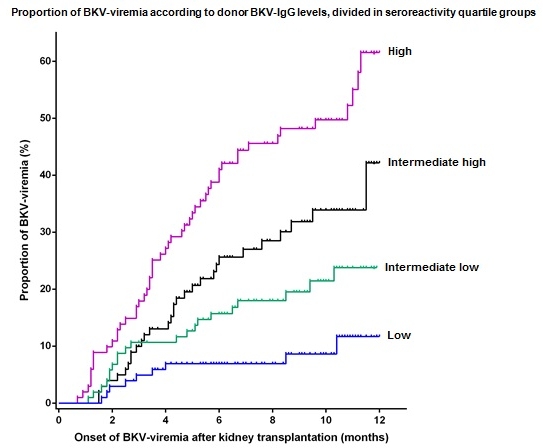BK Polyomavirus Seroreactivity of Kidney Donors Predicts Viremia and Nephropathy in Recipients.
1Medical Microbiology, LUMC, Leiden, Netherlands
2Nephrology, LUMC, Leiden, Netherlands
3Immunohematology and Blood Transfusion, LUMC, Leiden, Netherlands
4Medical Statistics and Bioinformatics, LUMC, Leiden, Netherlands
5UMR INRA 1282 ISP, Université
François Rabelais, Tours, France.
Meeting: 2016 American Transplant Congress
Abstract number: 434
Keywords: IgG, Kidney transplantation, Polyma virus, Risk factors
Session Information
Session Name: Concurrent Session: Kidney: Polyomavirus
Session Type: Concurrent Session
Date: Tuesday, June 14, 2016
Session Time: 2:30pm-4:00pm
 Presentation Time: 2:42pm-2:54pm
Presentation Time: 2:42pm-2:54pm
Location: Room 210
Background Kidney transplant (KTx) donors are not implicated in predicting BK polyomavirus (BKV) infection in the recipient. For BKV-associated nephropathy (BKVAN) however, donor origin of infection is likely. Since BKV-seroreactivity correlates with BKV-replication, we investigated whether baseline BKV-seroreactivity of KTx-donors predicts viremia and BKVAN in recipients.
Methods In a retrospective cohort of 407 living kidney allograft donor-recipient pairs, transplanted between 2003-2013, pre-KTx donor and recipient sera were tested for BKV IgG-levels. Baseline IgG-levels were correlated with the occurrence of viremia and BKVAN during the first year after transplantation.
Results Baseline BKV-seroprevalence of both donors and recipients was high, ≥ 95%. A strong, statistically significant association was observed between donor BKV-IgG level and occurrence of viremia (Figure1) and BKVAN. This resulted in a sevenfold increased hazard ratio for BKV-viremia, which increased even further in case of a low BKV-seroreactive recipient. Baseline recipient BKV-seroreactivity as such was not associated with viremia or BKVAN. Multivariate analysis showed donor BKV-seroreactivity to be the strongest baseline factor associated with BKV-viremia and BKVAN.

Conclusion Donor level of BKV-IgG is a strong predictor of BKV-infection in KTx-recipients. The proportional relation suggests that donor BKV-seroreactivity reflects the infectious load of the kidney allograft. This finding promotes the use of BKV-serological testing pre-KTx, in order to assess the risk of BKVAN and to personalize BKV-plasma load-monitoring. Furthermore, it emphasizes the relevance of strategies aimed to increase BKV-immunity in kidney allograft-recipients.
CITATION INFORMATION: Wunderink H, van der Meijden E, van der Blij-de Brouwer C, Mallat M, Haasnoot G, van Zwet E, Claas E, de Fijter J, Kroes A, Arnold F, Touzé A, Claas F, Rotmans J, Feltkamp M. BK Polyomavirus Seroreactivity of Kidney Donors Predicts Viremia and Nephropathy in Recipients. Am J Transplant. 2016;16 (suppl 3).
To cite this abstract in AMA style:
Wunderink H, Meijden Evander, Mallat M, Haasnoot G, Zwet Evan, Claas E, Fijter Jde, Kroes A, Arnold F, Touzé A, Claas F, Rotmans J, Feltkamp M. BK Polyomavirus Seroreactivity of Kidney Donors Predicts Viremia and Nephropathy in Recipients. [abstract]. Am J Transplant. 2016; 16 (suppl 3). https://atcmeetingabstracts.com/abstract/bk-polyomavirus-seroreactivity-of-kidney-donors-predicts-viremia-and-nephropathy-in-recipients/. Accessed July 1, 2025.« Back to 2016 American Transplant Congress
